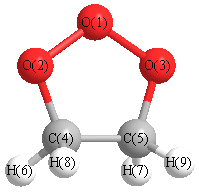Vibrational Frequencies calculated at MP4/6-31G*
| Mode Number |
Symmetry |
Frequency
(cm-1) |
Scaled Frequency
(cm-1) |
IR Intensities
(km mol-1) |
Raman Act
(Å4/u) |
Dep P |
Dep U |
|---|
| 1 |
A' |
3158 |
3016 |
|
|
|
|
| 2 |
A' |
3081 |
2942 |
|
|
|
|
| 3 |
A' |
1556 |
1486 |
|
|
|
|
| 4 |
A' |
1363 |
1301 |
|
|
|
|
| 5 |
A' |
1250 |
1194 |
|
|
|
|
| 6 |
A' |
1013 |
967 |
|
|
|
|
| 7 |
A' |
954 |
911 |
|
|
|
|
| 8 |
A' |
877 |
837 |
|
|
|
|
| 9 |
A' |
846 |
807 |
|
|
|
|
| 10 |
A' |
688 |
657 |
|
|
|
|
| 11 |
A' |
406 |
388 |
|
|
|
|
| 12 |
A" |
3142 |
3000 |
|
|
|
|
| 13 |
A" |
3072 |
2933 |
|
|
|
|
| 14 |
A" |
1540 |
1470 |
|
|
|
|
| 15 |
A" |
1362 |
1300 |
|
|
|
|
| 16 |
A" |
1239 |
1183 |
|
|
|
|
| 17 |
A" |
1168 |
1115 |
|
|
|
|
| 18 |
A" |
1031 |
985 |
|
|
|
|
| 19 |
A" |
733 |
700 |
|
|
|
|
| 20 |
A" |
670 |
639 |
|
|
|
|
| 21 |
A" |
109 |
104 |
|
|
|
|
Unscaled Zero Point Vibrational Energy (zpe) 14628.7 cm
-1
Scaled (by 0.9548) Zero Point Vibrational Energy (zpe) 13967.5 cm
-1
See section
III.C.1 List or set vibrational scaling factors
to change the scale factors used here.
See section
III.C.2
Calculate a vibrational scaling factor for a given set of molecules
to determine the least squares best scaling factor.
